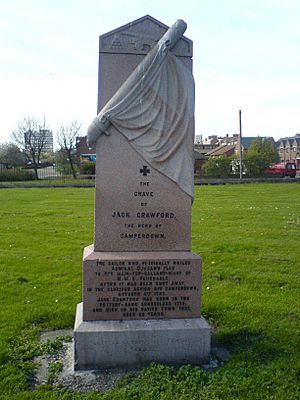Jack Crawford (sailor) facts for kids

Jack Crawford (22 March 1775–10 November 1831) was a sailor of the Royal Navy. He was most famous for his actions at the Battle of Camperdown in 1797, and so is known as the "Hero of Camperdown."
Crawford was born in the east end of Sunderland. He trained as a keelman until 1786 when he joined the crew of the Peggy at South Shields as an apprentice. He was still only 11 or 12 years old. In 1796, he was press-ganged into the Royal Navy and served on HMS Venerable under Admiral Duncan, the Royal Navy Commander-in-Chief of the North Seas.
At the Battle of Camperdown (11 October 1797), Venerable was Admiral Duncan's flagship. During the battle, part of the Venerable's mast was felled, including the admiral's flag. Lowering the Admiral's personal flag was a sign of surrender. Crawford climbed the mast and nailed the colours to the top.
After the victory procession in London he was formally presented to King George III of the United Kingdom and was given a government pension of £30 a year, and later a silver medal from the people of Sunderland. However, Crawford fell on hard times and had to sell his medal. He became the second victim of the cholera epidemic of 1831 and was buried in an unmarked "pauper's" grave.
Towards the end of the nineteenth century interest in the 'Hero of Camperdown' was renewed. A headstone was put up in Holy Trinity, Sunderland churchyard in 1888. Two years later a monument was erected in Mowbray Park, opposite what is now the Civic Centre.
A pub in Monkwearmouth was named the Jack Crawford and sported a carved figure of him on the side of the building. After the pub was destroyed during World War II, the figure was removed. In 1987 it was loaned to Sunderland Museum and put on display in the local history gallery but has been returned to the owner. The Museum holds Jack Crawford in high regard. There was an exhibition about him on the bicentenary of the Battle of Camperdown and there was a display about him in SeaBritain Year (2005). One of the Learning Rooms is named after him and there are several pieces of nineteenth century Jack Crawford commemorative pottery on display in the Pottery Gallery and the silver medal that was presented to him by the Town following the battle in 1797, and given to the Museum by the Earl of Camperdown in 1880, is proudly on display in the Sunderland Heroes section of the Museum Street near the entrance of this award winning Museum.

